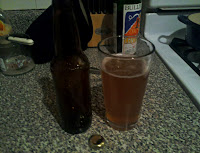I took a gravity reading of the Pilothouse Pilsner on Friday that came in at 1.012. The 1.012 reading was perfect, but the beer was extremely cloudy. I decided to "cold crash" the beer before I bottled it. Cold crashing is as easy as just putting the fermenter into your refrigerator. Some people do it for a couple days, some at least a week. The drop in temperature makes a lot of the yeast fall to the bottom of the fermenter, ultimately making a clearer beer. I only cold crashed for two days and definitely noticed an improvement when I bottled. With a final gravity of 1.012 the beer has an ABV of 6.0%.
Monday, May 21, 2012
Wednesday, May 16, 2012
Irish Red
I brewed an Irish Red extract recipe that included specialty grains last night. It was the first time I brewed using any kind of grains and it was actually very simple. Using specialty grains adds certain flavors and/or color to the beer that you cannot get from using extracts. The only downside, which is true with steeping any grains, is that the entire brew process takes longer. I purchased a 20 Quart Pot because I was tired of boil overs! If I ever decide to start brewing 5 gallon batches, this pot is big enough to handle it. I bought the pot for $59 on Friday and the price already rose to $67! The pot is perfect for pouring the wort into the fermenter as well. Here is the Irish Red recipe:
3 lbs. Golden Light Dry Malt Extract (DME)
2 oz. Light Roasted Barley (30 minutes)
8 oz. Crystal 60L (C-60) (30 minutes)
1/3 oz. Fuggles hops (60 minutes)
1/3 oz. Willamette hops (60 minutes)
1/3 oz. Fuggles hops (15 minutes)
1/3 oz. Willamette hops (15 minutes)
1/8 tsp. Irish Moss (15 minutes)
1/3 oz. Fuggles hops (5 minutes)
1/3 oz. Willamette hops (5 minutes)
Safale US-05 dry yeast
The recipe might look complex, but the bulk of it is 1 oz. of Fuggles and Willamette hops each broken down into thirds. I put the specialty grains in a ziplock bag and crushed them with a rolling pin. This method worked fine, but
I will have to come up with something better if I ever use larger amounts. I started brewing with 2 gallons of water. I could have used 1 gallon, but some people recommend an "as close to full volume boil as possible" so I gave it a shot. I added the C-60 and light roasted barley for 30 minutes while maintaining a temperature between 150°-160°. After 30 minutes, I removed the specialty grains, added the 3 lbs. of DME, and brought the wort to a boil. Once boiling, I restarted my timer for 60 minutes and added the first hops bag containing 1/3 oz. Fuggles and 1/3 oz. Willamette. I added the second hops bag and irish moss at 15 minutes, and the third hops bag at 5 minutes. The original gravity was 1.056. Even though it didn't look red at this stage it still smelled great!
I bottled the Witty Ging on Monday night, which free'd up the fermenter for this Irish Red recipe. The final gravity settled at 1.014, meaning the beer has an ABV of 6.2%. I'm very excited to see how this one turns out because it was my first brew that was not based from a Mr. Beer kit!
3 lbs. Golden Light Dry Malt Extract (DME)
2 oz. Light Roasted Barley (30 minutes)
8 oz. Crystal 60L (C-60) (30 minutes)
1/3 oz. Fuggles hops (60 minutes)
1/3 oz. Willamette hops (60 minutes)
1/3 oz. Fuggles hops (15 minutes)
1/3 oz. Willamette hops (15 minutes)
1/8 tsp. Irish Moss (15 minutes)
1/3 oz. Fuggles hops (5 minutes)
1/3 oz. Willamette hops (5 minutes)
Safale US-05 dry yeast
The recipe might look complex, but the bulk of it is 1 oz. of Fuggles and Willamette hops each broken down into thirds. I put the specialty grains in a ziplock bag and crushed them with a rolling pin. This method worked fine, but
 |
| 2 of the 3 hops bags that I used |
 |
| Witty Ging bottles |
Wednesday, May 9, 2012
Another Success!
I also put the remaining Witty Monk bottles into the fridge. The Witty Ging and Pilothouse Pilsner are almost done fermenting. I have to come up with more empty beer bottles in order to move them along!
Monday, May 7, 2012
Not quite ready?
Tuesday, May 1, 2012
Hot Break
This picture shows part of my set up on brew day. There are really only five things to note here. All the way on the left, you can see the two cans of Mr. Beer Hoppe Malt Extract (HME). They are soaking in hot water so they are easier to pour into the wort (they are still very sticky, but it helps). Before I add the HME cans, I replace the warm water with the sanitized solution from the
fermenter. I dip the opened can into the hot wort to get any remaining extract out. The fermenter is sitting next to the HME cans and is just filled with a gallon of the sanitized solution. In the back, there is a measuring cup covered with foil. That is what I use to rehydrate the yeast in one cup of water. To the right of the fermenter is another measuring cup filled with sanitized solution. I keep utensils (can opener and spatula in this picture) in there until I use them. The last thing is a small plate with the whisk. The plate has a little bit of the sanitized solution on it so I can continually put down the utensils without the risk of picking up any unwanted nasties.
Subscribe to:
Comments (Atom)





